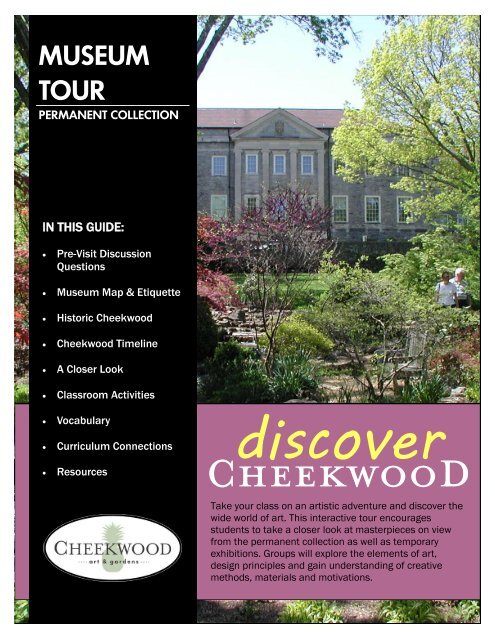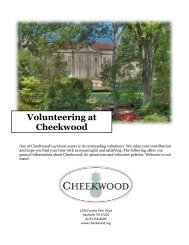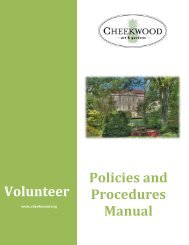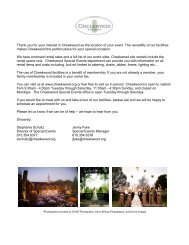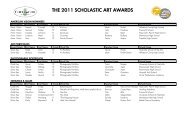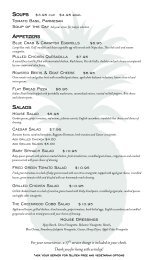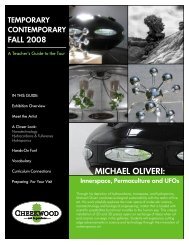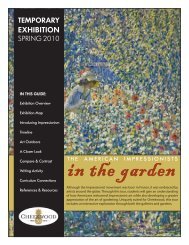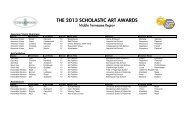Discover Cheekwood - Cheekwood Botanical Garden and Museum ...
Discover Cheekwood - Cheekwood Botanical Garden and Museum ...
Discover Cheekwood - Cheekwood Botanical Garden and Museum ...
- No tags were found...
Create successful ePaper yourself
Turn your PDF publications into a flip-book with our unique Google optimized e-Paper software.
MUSEUMTOURPERMANENT COLLECTIONIN THIS GUIDE:Pre-Visit DiscussionQuestions<strong>Museum</strong> Map & EtiquetteHistoric <strong>Cheekwood</strong><strong>Cheekwood</strong> TimelineA Closer LookClassroom ActivitiesVocabularyCurriculum ConnectionsResourcesdiscoverCheekwooDTake your class on an artistic adventure <strong>and</strong> discover thewide world of art. This interactive tour encouragesstudents to take a closer look at masterpieces on viewfrom the permanent collection as well as temporaryexhibitions. Groups will explore the elements of art,design principles <strong>and</strong> gain underst<strong>and</strong>ing of creativemethods, materials <strong>and</strong> motivations.
EXHIBITION OVERVIEWBefore you visit <strong>Cheekwood</strong>, we encourage you to share some of the background information fromthis Teacher‟s Guide with your students. Below are a few discussion questions to help prepare themfor the visit.WHAT IS ART?During your visit to <strong>Cheekwood</strong> you will view a variety of artwork.What is art? Is the definition of art the same to everyone?WHY DOES CHEEKWOOD COLLECT?<strong>Cheekwood</strong> is considered a collecting institution, which means that the collection will continue togrow over time. The collection is made up of approximately 8,000 objects! What is the differencebetween collecting <strong>and</strong> a collection? Why do you think <strong>Cheekwood</strong> collects objects?LANDSCAPE, PORTRAIT OR STILL LIFE?You will view different types of artwork in the museum, such as l<strong>and</strong>scapes, portraits <strong>and</strong> still lifes.What is the difference between these types of works?What do you expect to see when looking at them?WHAT MATERIALS ARE USED?Artists use all types of materials to create unique works of art.What types of materials do you expect artists to have used in artwork that is on display at<strong>Cheekwood</strong>?WHAT DO YOU WANT TO LEARN?<strong>Cheekwood</strong>‟s <strong>Museum</strong> of Art is over 50 years old <strong>and</strong> is an important part of the Nashvillecommunity. Have you visited <strong>Cheekwood</strong> before? What do you already know about<strong>Cheekwood</strong>? What do you hope to learn during your visit? (Teachers: Have your students usethe KWL chart on pg. 13 to help answer these questions.)<strong>Cheekwood</strong> changes the artwork <strong>and</strong> objects on display in the <strong>Museum</strong> of Art frequently. During your visit,select pieces discussed in this Teacher’s Guide may not be on view.1BEFORE YOUR VISIT
MUSEUM MAP & ETIQUETTEMUSEUM <strong>and</strong> GARDENETIQUETTEPrior to your visit, please review the <strong>Museum</strong><strong>and</strong> <strong>Garden</strong> Rules with your students.Visitors are asked to stay on the pathsfor the protection of the plantcollections <strong>and</strong> for their own safety.Please do not touch the plants orartwork. Stay at least an arm‟s lengthaway from works of art in the<strong>Museum</strong>.Speak in a normal „inside‟ voice.Please do not disturb guests in thegardens or galleries by yelling orshouting to others.Stay with your group. <strong>Cheekwood</strong> isvery large, <strong>and</strong> it is easy to getdistracted. We do not want anyone tobe separated from their group.Please leave any backpacks or largepurses at school or on the bus whilevisiting. Bulky objects might bump awork of art <strong>and</strong> damage it.Photography is not permitted in the<strong>Museum</strong> of Art, but students arewelcome to take pictures in thegardens.Students may only use pencils in thegalleries. Pens, markers, <strong>and</strong> crayonsare not allowed.BEFORE YOUR VISIT & WHEN YOU ARRIVE2
HISTORIC CHEEKWOODWithin its 55 acres, <strong>Cheekwood</strong> is a complex institution rich with history, beautiful gardens <strong>and</strong>nationally acclaimed art. The history of <strong>Cheekwood</strong> is intimately interwoven with the growth ofNashville, the Maxwell House coffee br<strong>and</strong> <strong>and</strong> the Cheeks, one of the city‟s early entrepreneurialfamilies. Here is their story.In 1890, Leslie Cheek moved with his family from Kentucky to Nashville to join his father‟s grocerybusiness in Cummins Station. Soon after joining his father‟s firm, Leslie Cheek met Mabel Wood,<strong>and</strong> they were married in 1896. Their son, Leslie Cheek, Jr. was born in 1908 <strong>and</strong> their daughter,Huldah Warfield Cheek, followed in 1915.While Leslie worked with his father in the grocery business, his cousin Joel developed a superiorblend of coffee. Members of the Cheek family invested in Cheek-Neal Coffee. Eventually, Joelconvinced the best hotel in Nashville, the Maxwell House, to carry his coffee exclusively, <strong>and</strong> theMaxwell House br<strong>and</strong> was born. When Joel Cheek sold his br<strong>and</strong> to Postum (now General Foods)for over $40 million in 1928, Leslie‟s investment in the coffee paid him well. Trading his Postumshares for IBM stock, Leslie secured his fortune. He <strong>and</strong> Mabel purchased 100 acres in WestNashville <strong>and</strong> built their dream house, which later became known as <strong>Cheekwood</strong>.The couple hired New York residential l<strong>and</strong>scape architect Bryant Fleming to create the 30,000square foot Georgian-style mansion with formal gardens. Built from limestone quarried on thegrounds, Fleming designed the home so that it appears to rise out of the hill. He also orchestratedthe placement of doors, windows <strong>and</strong> rooms to accentuate the views of gardens <strong>and</strong> l<strong>and</strong>scape,completely tying the house to the grounds in every aspect.Left to Right: Aerial view of <strong>Cheekwood</strong> during the time of the Cheeks; Guests awaiting the public opening of <strong>Cheekwood</strong> in 1960.3HISTORY OF THE CHEEK FAMILY & CHEEKWOOD
HISTORIC CHEEKWOODTo furnish the home, Mr. <strong>and</strong> Mrs. Cheek traveled with Fleming to Great Britain to buy antiques <strong>and</strong>furniture for the great mansion. After their return, four railcars were required to ship these treasuresto the location. Construction on the mansion began in 1929, ended in 1932, <strong>and</strong> was one of thelargest employers in Nashville during the Depression.In January 1933, Leslie <strong>and</strong> Mabel moved into their new home. Leslie lived only two years at<strong>Cheekwood</strong> before his death in 1935. Nine years later Mabel Cheek deeded the house to theirdaughter Huldah <strong>and</strong> her husb<strong>and</strong> Walter Sharp. In 1957, the Sharps offered the mansion <strong>and</strong> 55acres of l<strong>and</strong> for the establishment of a botanical garden <strong>and</strong> art museum. After renovations totransform the home into a true museum, <strong>Cheekwood</strong>‟s Fine Art Center opened to the public on May22, 1960 with a dedication given by Senator Albert Gore, Sr.Since 1960, <strong>Cheekwood</strong>‟s <strong>Museum</strong> of Art has acquired a diverse art collection that emphasizesAmerican <strong>and</strong> European paintings, prints, photographs, sculptures, <strong>and</strong> decorative arts. Throughpurchases <strong>and</strong> gifts, the art collection has grown to approximately 8,000 objects. The <strong>Botanical</strong><strong>Garden</strong> has also exp<strong>and</strong>ed, now featuring 19 different collections displayed within ten beautifulspecialty gardens. <strong>Cheekwood</strong>‟s plant collections include boxwoods planted by the Cheek family,daffodils, dogwoods, herbs, <strong>and</strong> many others.Today, <strong>Cheekwood</strong> continues to inspire <strong>and</strong> educate by making art, horticulture <strong>and</strong> natureaccessible to a diverse community.Left to Right: Leslie, Huldah, <strong>and</strong> Mabel Cheek before they embark on European buying trip; Drawing Room with theoriginal furnishings; Founders‟ Plaque recognizing those who contributed to make <strong>Cheekwood</strong> a museum <strong>and</strong> garden.did you know?In the 18 th century, ship captains would pick up pineapples while travelingaround South America. After arriving home from their voyage, they wouldplace the pineapples on their picket fence as a way of inviting friends <strong>and</strong>neighbors to share the fruits <strong>and</strong> spices they brought back. The Pineappleis a symbol of kindness <strong>and</strong> hospitality, <strong>and</strong> the Cheeks used itthroughout their home. As you explore the <strong>Museum</strong> of Art, keep an eyeout for pineapples. How many can you find?HISTORY OF THE CHEEK FAMILY & CHEEKWOOD4
CHEEKWOOD TIMELINE1890 C.T. Cheek moves from Kentucky to head wholesale grocery firm with hisfamily, including son, Leslie Cheek, Sr.1892 Joel Cheek develops masterful blend of coffee, later known as Maxwell HouseCoffee.1896 Leslie Cheek Sr. marries Mabel Wood in Clarksville, TN.1908 Leslie Cheek, Jr. is born. Huldah Warfield Cheek is born in 1915.1928 Postum (now General Foods) buys Maxwell House coffee business.1929 Cheeks buy 100 acres in West Nashville, <strong>and</strong> construction of <strong>Cheekwood</strong>begins.1933 The Cheeks move into the mansion in January.1935 Leslie Cheek Sr. <strong>and</strong> Joel Cheek die.1942 Huldah Cheek marries Walter Sharp.1944 <strong>Cheekwood</strong> is deeded to the Sharps.1957 The Sharps give <strong>Cheekwood</strong> to be a fine arts center (now the <strong>Museum</strong>of Art) <strong>and</strong> a botanical garden.1960 <strong>Cheekwood</strong> opens to the public on May 22.1968 Howe Wildflower <strong>Garden</strong> is relocated from private estate in East Nashville to<strong>Cheekwood</strong>.1980 Stallworth Galleries are added to the <strong>Museum</strong> of Art.1998 Frist Learning Center <strong>and</strong> Robertson Ellis Color <strong>Garden</strong> open.1999 Carell Woodl<strong>and</strong> Sculpture Trail <strong>and</strong> Turner Seasons <strong>Garden</strong> open.2000 <strong>Cheekwood</strong> is named to the National Register of Historic Places.2010 <strong>Cheekwood</strong> celebrates 50 years with Chihuly at <strong>Cheekwood</strong>.5TIMELINE
A CLOSER LOOKportraitA portrait is a resemblance or image of a person that is created by an artist. The person (or people) who haveposed for the portrait is called the sitter. Often times there are clues in portraits that tell us more about theperson or their association. These clues are called symbols. Symbols represent something else by association.Portrait of William McCrackenGilbert Stuart (American, 1755-1828) | N.D., Oil on canvasFrom the beginning of his career, Stuart focused on painting portrait busts. This portrait is ofWilliam McCracken, a bishop from Dublin. It was painted to commemorate McCracken‟s part infounding the first Sunday School program in Belfast. The letter that he holds says, “Since thenwe can no longer have your presence as usual permit us to request a Memento to remind us ofhim who has been The Father of our Schools.”While painting the head <strong>and</strong> shoulder view, Stuart found that he could describe the sitter‟spersonality through facial features without the distraction of busy backdrops. After studyingunder many notable artists, he developed a unique style that departed from tradition with hisuse of color <strong>and</strong> soft line. As a result, his portraits achieved a likeness more genuine <strong>and</strong>accurate than those of his rival painters.did you know?Where have you seen a Gilbert Stuart portrait before? Stuart‟sportrait of George Washington was engraved on the one dollar bill.The Ephraim Hubbard Foster FamilyRalph E.W. Earl (American, 1785-1838) | 1825 | Oil on mattress tickingRalph E.W. Earl studied under his father, portrait painter Ralph Earl, <strong>and</strong> becameknown as “the king painter” for his numerous portraits of President AndrewJackson. He became so close to Jackson that he was buried in the cemetery ofJackson‟s Nashville home, the Hermitage.By the time Earl painted this portrait, Colonel Ephraim Hubbard Foster had alreadyestablished himself as private secretary to General Andrew Jackson, havingserved Jackson during the Creek War of 1813-1815 at the battles of Talledega, Enoctochopee, Emuefaw, <strong>and</strong> Topeka.In 1817 Foster married Jane Dickinson, the widow of the attorney for whom he apprenticed. Foster was admitted to thebar in 1820 <strong>and</strong> developed a thriving practice. He was known for his wit <strong>and</strong> temper.This portrait shows Foster at one of the high points in his life. He is about 35 years old <strong>and</strong> is surrounded by his wife<strong>and</strong> five children. The portrait shows the Fosters as a wealthy family in expensive clothing <strong>and</strong> elegant furnishings,unlike the usual accommodations in Nashville during 1825. Earl added personal touches to the painting, such as thepenny whistle <strong>and</strong> the extravagant hat that the young daughter is wearing. All members of the family are touching insome way <strong>and</strong> the baby in Jane‟s lap is sucking his fingers. The baby was born while the portrait was being completed,<strong>and</strong> was painted in later (as indicted by the way the child‟s contour follows the folds of the mother‟s dress).PORTRAIT6
A CLOSER LOOKPortrait ofAndy WarholJamie Wyeth | 1976Oil on panelPortrait of JamieWyeth with TanBackgroundAndy Warhol | 1976Acrylic <strong>and</strong> silkscreenAndy Warhol was born Andrew Warhola in Pittsburgh on August 6, 1928. Warhol moved from Pittsburgh to New York inthe 1950s, <strong>and</strong> quickly became a successful commercial artist, best known for his illustrations of I. Miller shoes. By the1960s, he began to experiment with images of popular culture <strong>and</strong> mass media, creating large paintings <strong>and</strong> prints ofrecognizable images such as Campbell‟s soup cans, Marilyn Monroe <strong>and</strong> Coca-Cola bottles. To this day, he isconsidered one of the most prominent figures of the Pop Art movement.Jamie Wyeth was born on July 6, 1946 in Wilmington, Delaware. Surrounded by a family of artists (his father wasfamous American artist Andrew Wyeth), he left school after sixth grade to be tutored <strong>and</strong> devote more time to his art.By the time he was 18, his paintings hung in the permanent collections of the Wilmington Society of Art in Wilmington,Delaware, in the William A. Farnsworth Library <strong>and</strong> Art <strong>Museum</strong> in Rockl<strong>and</strong>, Maine, <strong>and</strong> in several private collections.In 1973, he was part of a Wyeth Family exhibition at the Br<strong>and</strong>ywine River <strong>Museum</strong>, which helped to draw furtherattention to his artwork. This was followed by a retrospective of his work from 1975-1976 at the Joslyn Art <strong>Museum</strong> inOmaha, Nebraska. In 1976, he met Andy Warhol during a dinner <strong>and</strong> the two artists decided to create portraits of eachother. They spent two months at “The Factory” (Warhol‟s studio) creating their paintings.ask your studentsPortrait of Leslie Cheek, Sr.Richard Jack (American, 1866-1952)N.D., Oil on canvasPortrait of Mabel CheekRaymond P.R. NeilsonN.D., Oil on canvasThese two portraits are of Leslie <strong>and</strong> Mabel Cheek, who built <strong>and</strong> lived at <strong>Cheekwood</strong> before it became a<strong>Museum</strong> of Art. Use the questions below to engage your students in a conversation about portraits.What <strong>and</strong> who do you see in these portraits?What colors <strong>and</strong> shapes do you see in these paintings?Why do you think these portraits are located in the foyer of the <strong>Museum</strong> of Art?What can you learn about the sitters from looking at these portraits?What difficulties do you think the artist would have in painting portraits like these?7PORTRAIT
A CLOSER LOOKl<strong>and</strong>scapeA l<strong>and</strong>scape is a painting, drawing or photograph of scenery. Cityscapes <strong>and</strong> seascapes are different types ofl<strong>and</strong>scapes that focus specifically on the scenery of a city or ocean view.BelmontArtist Unknown | 1859-1860 | Oil on canvasThis painting symbolizes the wealth <strong>and</strong> prosperity ofBelmont‟s first owners, Joseph <strong>and</strong> Adelicia Acklen. TheAcklens built Belmont with the Italian l<strong>and</strong>scape in mind.The house plans were acquired during a trip to Italy, <strong>and</strong>the surrounding gardens were done in a Mediterraneanstyle. The estate‟s name – Belmont, even came fromShakespeare‟s The Merchant of Venice. After Josephpassed away in 1863, Adelicia managed Belmont, as wellas plantations in Louisiana <strong>and</strong> Texas, <strong>and</strong> became one ofthe wealthiest women in America. Today, the mansionst<strong>and</strong>s at the center of Belmont University.In Belmont is a lady richly left; And she is fair, <strong>and</strong>, fairerthan that word, Of wondrous virtues…-Shakespeare, The Merchant of VeniceMilton on the HudsonGeorge Inness | 1882 | Oil on linenGeorge Inness is regarded as a master of late 19 thcentury painting. He was born in Newburgh, New York in1825. Interested in art from an early age, he studiedengraving <strong>and</strong> painting. In 1844, he exhibited for thefirst time at the National Academy of Design. He wasinterested in the work of the Hudson River School, butin 1854, he traveled to France to study l<strong>and</strong>scapes atthe Barbizon School. In the late 1870s, Inness settled inNorthern New Jersey, while maintaining a studio in NewYork.In Milton on the Hudson, he captured the gr<strong>and</strong>American l<strong>and</strong>scape while paying careful attention tolight <strong>and</strong> subject matter. In this piece, Inness strived tocreate a composition that illustrates the harmonybetween man <strong>and</strong> nature in a chaotic world.LANDSCAPE8
A CLOSER LOOKCheat River GorgeArtist Unknown | N.D. | Oil on canvasThis painting of the Cheat River Gorge in Coopers RockState Forest, West Virginia showcases the gr<strong>and</strong>eur ofnature – a style that was typical of the Hudson RiverSchool. The School was a group of New York City-basedl<strong>and</strong>scape painters that emerged around 1850 under theinfluence of artist, Thomas Cole. Their painting style oftendepicted scenes of the American l<strong>and</strong>scape, commentedon the cycle of life (contrasting the new with the old), <strong>and</strong>were often very large in size.This piece is a series of converging angled lines, allleading to the center of the painting. The viewer is ledinto the painting by natural <strong>and</strong> man-made diagonals, including the sunlight, river <strong>and</strong> railroad. In the foreground, we seetwo trees, one that is old <strong>and</strong> dying <strong>and</strong> the other a young sapling. To the left of the trees are people that were paintedvery small, obviously insignificant to the nature that is the highlight of the piece. On the right side of the painting, there isa railroad trestle. The railroad symbolizes Manifest Destiny, the westward expansion that took place during the 19 thcentury.Pont des Arts, ParisRed Grooms | 2005 | Watercolor on paperRed Grooms was born in Nashville in 1937. In the1950s, he left Music City to live <strong>and</strong> study art in NewYork City. As a sculptor, painter, performer <strong>and</strong>storyteller, his artwork today is immensely popular<strong>and</strong> is shown around the world. He works in a varietyof media, <strong>and</strong> draws in his viewers through his uniquecompositions <strong>and</strong> subject matter.Pont des Arts, Paris was painted on site by Grooms atthe famous pedestrian bridge in France that hasbecome an important center of activity for artists. Thelocation is now referred to as the studio en plein air,the outdoor studio. In this watercolor, he also givesviewers a look at the Louvre in the background.ask your studentsWhat is a l<strong>and</strong>scape?What subject matter do you think you would commonly see in a l<strong>and</strong>scape?What can the colors in a l<strong>and</strong>scape tell you about the season or time of day depicted by the artist?Find a l<strong>and</strong>scape in the museum <strong>and</strong> determine where the foreground, middleground <strong>and</strong> background are?Where is the horizon line?9LANDSCAPE
A CLOSER LOOKstill lifeA still life is a work of art that depicts mostly inanimate <strong>and</strong> commonplace objects such as food, flowers,books, <strong>and</strong> vases in an artificial <strong>and</strong> planned setting. Today, we take the idea of still life for granted. Anarrangement of fruit, flowers, <strong>and</strong> beautiful objects seems like a natural subject for a painting, but this wasnot always the case. Still life emerged as an independent subject around 1600, when growing interest in thenatural world led to its simultaneous appearance in northern Europe, Italy, <strong>and</strong> Spain. Ever since, it hasplayed a prominent role in the history of art.Still Life with FruitSeverin Roesen | 1860 | Oil on canvasRoesen began his career as a porcelain painter in Germany. Since 19 thcentury German porcelain often displayed floral designs, that experienceprovided a good foundation for still life painting. He may have alsobenefited from early exposure to 17 th <strong>and</strong> 18 th century Dutch paintings offruit <strong>and</strong> flowers, as well as from the 19 th century works that revived thestill life tradition.In the late 1840s, Roesen immigrated to the United States. His lavish still life paintings of fruit <strong>and</strong> flowers established atradition for the genre in 19 th century America as well as the style for large canvases suitable for dining room decoration.Roesen‟s work, as evident in Still Life with Fruit, reveals his training as a painter of enamels <strong>and</strong> china through crispdrawing, bright colors <strong>and</strong> smooth surfaces. The artist greatly popularized still life painting - a genre that did not developinto a substantial tradition in the United States until the 1850s <strong>and</strong> 1860s.Large Etruscan-shaped VaseBarr, Flight & Barr | N.D. | Porcelainask your studentsThe factories of Barr, Flight <strong>and</strong> Barr created some of the best neoclassical shapesfollowing the direction of the French porcelain market. Wealthy individuals collected Greek<strong>and</strong> Roman art during their travels so to display such objects in their homes. This vase isclassical in style with an urn shape, animal paw feet, <strong>and</strong> angular h<strong>and</strong>les with satyr headmasks on each side.The front of this urn has been painted with a complex still life of seashells. The backgroundhas shading from light to dark. The manner for painting realistic shells on porcelain probablystarted in Paris <strong>and</strong> was introduced at Worcester around 1802. The piece appears to havebeen painted from an actual still life display of shells (since it looks so realistic) <strong>and</strong> mayhave been inspired by specimens in collector‟s books.Why are these types of works called ‘Still Life?’Do the objects in the piece need to be realistic looking? Or, can they be abstract?Is a still life always a painting?Can it be portrayed in any other art forms?STILL LIFE10
A CLOSER LOOKCheekwooD?What else might you see atARCHITECTURE<strong>Cheekwood</strong> is a 30,000-square-foot Georgian-style mansion thatwas designed by residential <strong>and</strong> l<strong>and</strong>scape architect BryantFleming. Look for unique architectural features, including a „fake‟dome that opens into the attic, not the sky!DECORATIVE ARTSTROMP L’OEILLining the hallway on the Loggia level of the <strong>Museum</strong> of Art are paintingson canvas that were done in the Italian manner, probably during the early19 th century. The allegorical trompe l‟oeil (which means “fool the eye” bycreating a three-dimensional appearance) panels portray the arts such asmusic, drama, painting <strong>and</strong> sculpture. The four upper panels depict theseasons. The Cheeks purchased the original panels in Europe <strong>and</strong> hadcomplimentary murals painted to complete the set.<strong>Cheekwood</strong> has a diverse collection of decorative arts objects, whichincludes Worcester porcelain, American <strong>and</strong> English silver, 18 th <strong>and</strong>19 th century snuff bottles, furniture, glass <strong>and</strong> American art pottery.SCULPTURESculpture can be found both indoors <strong>and</strong> outdoors at <strong>Cheekwood</strong>!This is Schoolteacher by William Edmondson. As a Nashville artistduring the 1930s, he transformed limestone into art. He also carvedtombstones <strong>and</strong> created “critters” such as rabbits, turtles <strong>and</strong>horses. <strong>Cheekwood</strong> has over twenty Edmondson pieces in thecollection.Interested in seeing outdoor sculpture? Check out the Carell Woodl<strong>and</strong> Sculpture Trail – a mile long path that featurescontemporary sculpture by internationally recognized artists.11ARCHITECTURE • SCULPTURE •DECORATIVE ARTS • TROMP L’OEIL
CLASSROOM ACTIVITIES*Reproducible Activity Sheet<strong>Museum</strong> Label Writing<strong>Cheekwood</strong>‟s labels are located near a piece of artwork or object in the museum. These labelsprovide information about the artist, subject matter <strong>and</strong> time period.Now that you have toured <strong>Cheekwood</strong>‟s <strong>Museum</strong> of Art, remember your favorite piece <strong>and</strong> becomethe curator! Write your own museum label below. Be sure to include information about what yousaw in the piece <strong>and</strong> why it was of interest to you.LABEL WRITING12
CLASSROOM ACTIVITIES*Reproducible Activity SheetWhat do I KNOWabout <strong>Cheekwood</strong>?KWL ChartWhat do I WANT toknow about<strong>Cheekwood</strong>?What did I LEARNduring my visit to<strong>Cheekwood</strong>?13KWL CHART
CLASSROOM ACTIVITIESClassroom <strong>Museum</strong>Now that you have visited <strong>Cheekwood</strong> <strong>and</strong> learned about the history <strong>and</strong>collection, create your own classroom museum back at school!1.Have students take on the role of different museum professionals. You may need a curator,educators, director, greeters, exhibition designer, gift shop manager, accountant <strong>and</strong> others. Asstudents start to create their classroom museum, ask them to think about the role that thisperson would play in the museum setting.2.Research the history of the school. Have a student be in charge of writing up this informationfor visitors to see.3.4.5.6.7.Ask students to look for <strong>and</strong> collect objects around the classroom (or school) that would begood to display in the museum. Write labels to describe these objects.Think about how the objects should be displayed. If it is a two-dimensional piece, it can hang ona wall. Three-dimensional pieces should be out in the open so visitors can walk around them.Create a museum map with information on where objects are located.Once the classroom museum is complete – hold your opening event. Invite other classes,teachers <strong>and</strong> the principal to come <strong>and</strong> see your hard work!Don‟t forget to have someone take photographs for your archives. In ten years a new classmight want to learn about the history of your school <strong>and</strong> classroom, <strong>and</strong> your museum couldhelp them!CLASSROOM MUSEUM14
VOCABULARYCollectionA collection is a group of objects collected for their interest, value or beauty.Country EstateA country estate is a large home with a garden designed between 1895-1940 by the new wealthy class inAmerica. Their goal was a restful, quiet environment where they could escape the stresses of the city in theirelaborately designed gardens.CuratorA curator is someone who organizes <strong>and</strong> chooses the items in an exhibition at a museum or gallery.Decorative ArtsExamples of decorative arts are basketry, furniture, glassware <strong>and</strong> pottery. The focus is the design <strong>and</strong>decoration of the object, <strong>and</strong> it was primarily appreciated for utility rather than aesthetic qualities.Hudson River SchoolThe Hudson River School was a group of New York City-based l<strong>and</strong>scape painters that emerged around 1850under the influence of Thomas Cole.L<strong>and</strong>scapeA l<strong>and</strong>scape is a painting, drawing, or photograph of scenery.Manifest DestinyManifest Destiny was the 19 th century westward expansion of America, from the Atlantic to the Pacific.Pop ArtPop Art was an art movement from the 1950s to 1970s that incorporated modern popular culture <strong>and</strong> the massmedia.PortraitA portrait is a painting, photograph, or drawing of somebody, somebody's face, or a related group.SculptureSculpture is a three-dimensional work of art often made from materials that have been carved, molded, welded,sewn, or assembled.SitterA sitter is a person or people who have posed for a portrait.Still LifeA still life is the depiction of inanimate objects for the sake of their qualities of form, color, texture, <strong>and</strong>composition.SymbolsA symbol is an element of communication that simply represents or st<strong>and</strong>s for a complex person, object or idea.Tromp L’oeilIn French tromp l‟oeil means, “deceive the eye.” It is a piece of art that tricks the viewer‟s idea of reality.15TERMS & DEFINITIONS
CURRICULUM CONNECTIONSVISUAL ART2.0 Structures <strong>and</strong> FunctionsUnderst<strong>and</strong> that art has a purpose.Explain the elements of art <strong>and</strong> principles of design found in selected artwork.3.0 Evaluation Explain subject matter, symbols, <strong>and</strong> ideas in others‟ art.4.0 Historical <strong>and</strong> Cultural RelationshipsUnderst<strong>and</strong> <strong>and</strong> demonstrate that art comes from different cultures, times, <strong>and</strong> places.Underst<strong>and</strong> <strong>and</strong> demonstrate how culture, history, <strong>and</strong> art influence each other.5.0 Reflecting <strong>and</strong> AssessingUnderst<strong>and</strong> <strong>and</strong> demonstrate that viewers have different responses to art.Evaluate intentions <strong>and</strong> factors that motivate artists to create art.LANGUAGE ARTSSt<strong>and</strong>ard 1 – LanguageDemonstrate knowledge of strategies <strong>and</strong> resources to determine the definition, pronunciation, <strong>and</strong>usage of words <strong>and</strong> phrases.St<strong>and</strong>ard 2 – CommunicationDemonstrate critical listening skills essential for comprehension, evaluation, problem solving, <strong>and</strong>task completion.Continue to develop strategies for expressing thoughts <strong>and</strong> ideas clearly <strong>and</strong> effectively.St<strong>and</strong>ard 5 – Logic Develop logic skills to enhance thoughtful reasoning <strong>and</strong> to facilitate learning.SOCIAL STUDIESSt<strong>and</strong>ard 1 – CultureUnderst<strong>and</strong> the diversity of human cultures.Recognize the contributions of individuals <strong>and</strong> people of various ethnic, racial, religious,socioeconomicTN STATE STANDARDS16
RESOURCESFor additional information on art <strong>and</strong> objects in <strong>Cheekwood</strong>’s collection, check out thefollowing resources:ONLINE<strong>Cheekwood</strong> <strong>Botanical</strong> <strong>Garden</strong> & <strong>Museum</strong> of Artwww.cheekwood.orgBOOKS<strong>Cheekwood</strong> <strong>Museum</strong> of Art Collection Catalog;Celia Walker, Kaye Crouch, Katie Delmez, Rusty Freeman, Lisa Porter,Karin Sack, Terri Smith, Dr. John Wetenhall, 2001The Ewers-Tyne Collection of Worcester Porcelain at <strong>Cheekwood</strong>; JohnS<strong>and</strong>on, 2008The Art of William Edmondson; Robert Farris Thompson, Bobby L.Lovett, Rusty Freeman, Judith McWillie, Grey Gundaker, <strong>and</strong> LoweryStokes Sims, 1999Tennessee Silversmiths; Dr. Benjamin H. Caldwell Jr., 1988Elements of Design: A Practical Encyclopedia of The Decorative Artsfrom the Renaissance to the Present; Noel Riley, 2003Saving Stuff: How to Care for <strong>and</strong> Preserve Your Collectibles, Heirlooms,<strong>and</strong> Other Prized Possessions; Don Williams <strong>and</strong> Louisa Jaggar, 200517BOOKS•WEBSITES
William Edmondson, Schoolteacher, limestone, acquired in 1960CLASSROOM IMAGEEDMONDSON’S SCHOOLTEACHER18
EDUCATION & PUBLIC PROGRAMS DEPARTMENT353-9827 • schooltours@cheekwood.org


